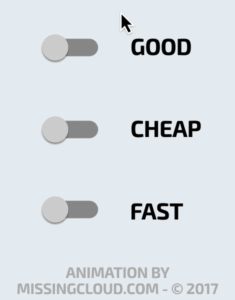It is common to hear you can choose two of the following, “Good”, “Cheap” or “Fast”. While there is clearly some truth to this, it is not an absolute truth.
This is especially true in the context of Digital Signatures in the United States where the law allows for parties to agree to rely on virtually any mechanism to capture an agreement. The rationale behind this is that in the event of a dispute it is the claimant in the dispute who will need to prove consent, as such, it is the parties of an agreement who must assume the burden of choice.
This introduces economic incentives to the decision-making process, specifically, it encourages you to consider which digital signature solution to apply to a given problem. This is an inherently good goal because over-specification in regulations can create market forces that result in the wrong solution being applied to a given business problem.
This flexibility also has downsides, specifically when people look to build a product to enable digital signatures this flexibility diminishes the economic incentives for them to build the most secure solution. Instead, their goal becomes to build the solution they think they can sell with minimal investment.
This, in theory, should still encourage providers to build a strong solution in that, if documents signed with their product end up being thrown out in court their business will ultimately fail. The problem with this motivation is that it can take a decade or more for this to become a concern that can hurt their business. As such, they double down on the creation of a solution that can be taken to market quickly.
It is easy to see this play out in the US Digital Signature market, the large majority of solutions do little more than produce an image that looks like “a signature” and then embeds it into a document. In the European Union, they call this a “Simple Signature”. To produce a fraudulent signature with such a scheme you typically need to select the signature with your mouse, right-click, select copy and then paste the image into the fraudulent document. These solutions are typically very easy to use and cheap to build but is clearly not a technique you would want to use on an agreement that might need to be enforced in a court of law.
Some solutions try to make these Simple Signatures stronger by taking a hash of the document with the signature in it and placing it in a database on their servers. This is done so that in the event of a dispute you can ask the service provider to go to court with you and act as an expert, stand by your side, and say “the hash is the same one we saw when they signed the document”. This is better than the pure image approach but not by much. This is true if for no other reason than they are unlikely to assign legal support to every contract dispute that happens involving contracts signed with their service. Additionally, if the legitimacy of the contract is put into question and the site has had any security incidents at all since it was signed, the claims they make would be questionable at best.
Other Simple Signature solutions try to mitigate these issues by applying a cryptographic notarization to the document after the basic Simple Signature was applied. This adds the concept of a trustworthy notarization of when the document was signed and to some degree, makes the document capable of standing on its own. Now if the original electronic document was produced with standards-based software anyone can confirm it has not been tampered with since it was produced. This helps you reduce the legal exposure relating to a compromise of the signing service which certainly helps with the enforceability but it does not eliminate this risk. This is because a slightly more difficult compromise of the service could still result in a bad actor producing a false document.
The next step up in enforceability is generally referred to as an “Advanced Signature”. These Advanced Signatures almost always start as a “Simple Signature” but they will also include signing the document with a cryptographic key under the sole control of the signer. This provides assurances that it was the user, and not the digital signature service, that signed the document.
Practically speaking the final step in enforceability when it comes to digital signatures is referred to as a “Qualified Signature”. This builds on the previous two types and of signatures and adds in two requirements. The first of which is that the key to being managed on a specialized cryptographic appliance such as a smart card or hardware security module. The rationale for this is that signing keys are typically long-lived and keys stored in software are exposed to theft. This is important because if an attacker steals one of these keys then they can produce fraudulently signed documents with it. The second requirement is that a the legal identity of the signer needs to be verified and included in the digital signature. This is in contrast to the other types of signatures which in essence only require the signer to be uniquely identified, in other words, something as basic as an email ping could be considered sufficient.
What has happened in the US is that since the law does not require anything stronger than a Simple Signature outside of areas like healthcare and finance where there are either regulatory requirements or business risks that justify a better solution we see only the Simple Signatures in use.
The vendors of these products would probably tell you they don’t do these more enforceable solutions because of you have to choose two of the following Fast, Cheap or Secure.
In the European Union, you have had the opposite problem, the economic incentives of the vendors and the associated regulatory frameworks have sent their market down the path of trying to apply Qualified Signatures to nearly all transactions. This reality has hampered the adoption of electronic signatures limiting their use to the highest value transactions due to the associated onboarding and use time friction this approach typically entails.
I believe this is an example of market failure and that it is possible to build a solution that scales across a businesses enforceability needs. One of the key reasons the market has not yet delivered such a solution is that the economic incentives for the vendors are not well aligned with those of their customers.
Tides are changing in both the US and in the European Union and I believe we will see a convergence of the best of both solutions in the coming years but as of yet, such a solution has not found its way to the market.

